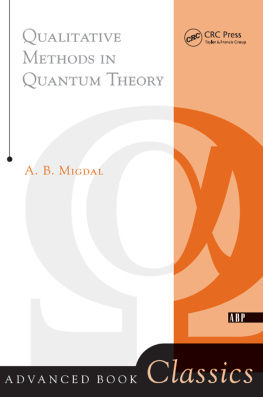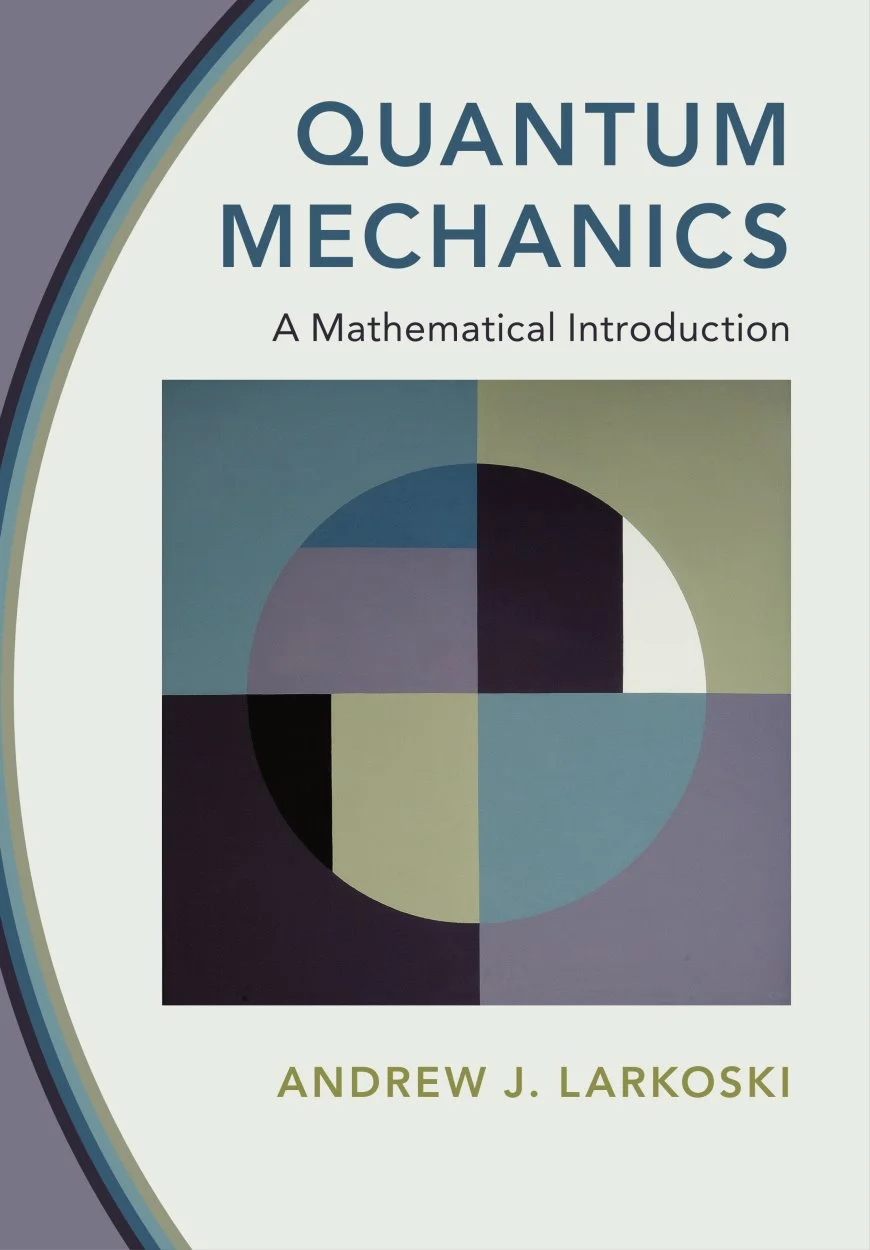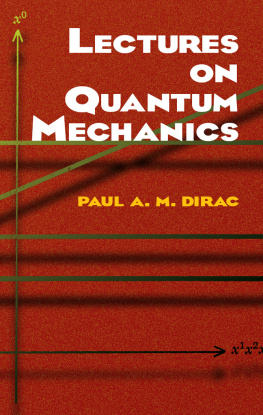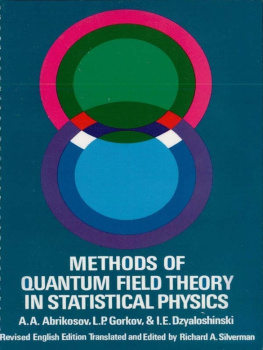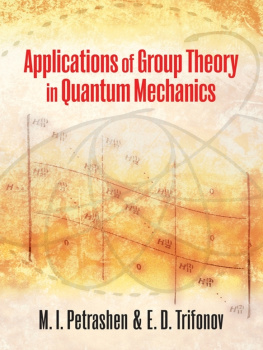A.B. Migdal - Qualitative Methods in Quantum Theory
Here you can read online A.B. Migdal - Qualitative Methods in Quantum Theory full text of the book (entire story) in english for free. Download pdf and epub, get meaning, cover and reviews about this ebook. year: 2000, publisher: Westview Press, genre: Children. Description of the work, (preface) as well as reviews are available. Best literature library LitArk.com created for fans of good reading and offers a wide selection of genres:
Romance novel
Science fiction
Adventure
Detective
Science
History
Home and family
Prose
Art
Politics
Computer
Non-fiction
Religion
Business
Children
Humor
Choose a favorite category and find really read worthwhile books. Enjoy immersion in the world of imagination, feel the emotions of the characters or learn something new for yourself, make an fascinating discovery.
- Book:Qualitative Methods in Quantum Theory
- Author:
- Publisher:Westview Press
- Genre:
- Year:2000
- Rating:3 / 5
- Favourites:Add to favourites
- Your mark:
- 60
- 1
- 2
- 3
- 4
- 5
Qualitative Methods in Quantum Theory: summary, description and annotation
We offer to read an annotation, description, summary or preface (depends on what the author of the book "Qualitative Methods in Quantum Theory" wrote himself). If you haven't found the necessary information about the book — write in the comments, we will try to find it.
Qualitative Methods in Quantum Theory — read online for free the complete book (whole text) full work
Below is the text of the book, divided by pages. System saving the place of the last page read, allows you to conveniently read the book "Qualitative Methods in Quantum Theory" online for free, without having to search again every time where you left off. Put a bookmark, and you can go to the page where you finished reading at any time.
Font size:
Interval:
Bookmark:

Qualitative Methods in Quantum Theory
Qualitative Methods in Quantum Theory
A. B. Migdal
I. V. Kurchatov Atomic Energy Institute
Moscow, Russia
Translated from the Russian edition by
Anthony J. Leggett
University of Sussex

First published 1977 by Westview Press
Published 2018 by CRC Press
Taylor & Francis Group
6000 Broken Sound Parkway NW, Suite 300
Boca Raton, FL 33487-2742
CRC Press is an imprint of the Taylor & Francis Group, an informa business
Copyright 1977 by W. A. Benjamin, Inc.
No claim to original U.S. Government works
This book contains information obtained from authentic and highly regarded sources. Reasonable efforts have been made to publish reliable data and information, but the author and publisher cannot assume responsibility for the validity of all materials or the consequences of their use. The authors and publishers have attempted to trace the copyright holders of all material reproduced in this publication and apologize to copyright holders if permission to publish in this form has not been obtained. If any copyright material has not been acknowledged please write and let us know so we may rectify in any future reprint.
Except as permitted under U.S. Copyright Law, no part of this book may be reprinted, reproduced, transmitted, or utilized in any form by any electronic, mechanical, or other means, now known or hereafter invented, including photocopying, microfilming, and recording, or in any information storage or retrieval system, without written permission from the publishers.
For permission to photocopy or use material electronically from this work, please access www.copyright.com (http://www.copyright.com/) or contact the Copyright Clearance Center, Inc. (CCC), 222 Rosewood Drive, Danvers, MA 01923, 978-750-8400. CCC is a not-for-profit organization that provides licenses and registration for a variety of users. For organizations that have been granted a photocopy license by the CCC, a separate system of payment has been arranged.
Trademark Notice: Product or corporate names may be trademarks or registered trademarks, and are used only for identification and explanation without intent to infringe.
Visit the Taylor & Francis Web site at
http://www.taylorandfrancis.com
and the CRC Press Web site at
http://www.crcpress.com
A CIP catalog record for this book is available from the Library of Congress.
ISBN 13:978-0-7382-0302-7 (pbk)
ADVANCED BOOK CLASSICS
David Pines, Series Editor
Anderson, P.W., Basic Notions of Condensed Matter Physics
Bethe H. and Jackiw, R., Intermediate Quantum Mechanics, Third Edition
Cowan, G. and Pines, D., Complexity: Metaphors, Models, and Reality
de Gennes, P.G., Superconductivity of Metals and Alloys
dEspagnat, B., Conceptual Foundations of Quantum Mechanics, Second Edition
Feynman, R., Photon-Hadron Interactions
Feynman, R., Quantum Electrodynamics
Feynman, R., Statistical Mechanics
Feynman, R., The Theory of Fundamental Processes
Gell-Mann, M. and Neeman, Y., The Eightfold Way
Khalatnikov, I. M. An Introduction to the Theory of Superfluidity
Ma, S-K., Modern Theory of Critical Phenomena
Migdal, A. B., Qualitative Methods in Quantum Theory
Negele, J. W. and Orland, H., Quantum Many-Particle Systems
Nozires, P., Theory of Interacting Fermi Systems
Nozires, P. and Pines, D., The Theory of Quantum Liquids
Parisi, G., Statistical Field Theory
Pines, D., Elementary Excitations in Solids
Pines, D., The Many-Body Problem
Quigg, C., Gauge Theories of the Strong, Weak, and Electromagnetic Interactions
Schrieffer, J.R., Theory of Superconductivity, Revised
Schwinger, J., Particles, Sources, and Fields, Volume I
Schwinger, J., Particles, Sources, and Fields, Volume II
Schwinger, J., Particles, Sources, and Fields, Volume III
Schwinger, J., Quantum Kinematics and Dynamics
Wyld, H.W., Mathematical Methods for Physics
CONTENTS
Perseus Publishings Frontiers in Physics series has, since 1961, made it possible for leading physicists to communicate in coherent fashion their views of recent developments in the most exciting and active fields of physicswithout having to devote the time and energy required to prepare a formal review or monograph. Indeed, throughout its nearly forty year existence, the series has emphasized informality in both style and content, as well as pedagogical clarity. Over time, it was expected that these informal accounts would be replaced by more formal counterpartstextbooks or monographsas the cutting-edge topics they treated gradually became integrated into the body of physics knowledge and reader interest dwindled. However, this has not proven to be the case for a number of the volumes in the series: Many works have remained in print on an on-demand basis, while others have such intrinsic value that the physics community has urged us to extend their life span.
The Advanced Book Classics series has been designed to meet this demand. It will keep in print those volumes in Frontiers in Physics that continue to provide a unique account of a topic of lasting interest. And through a sizable printing, these classics will be made available at a comparatively modest cost to the reader.
The late Arkady B. Migdal was one of the great theoretical physicists of our time, who made significant contributions to nuclear physics, condensed matter physics, astrophysics, and particle physics. He combined keen physical insight with a deep understanding of physics and physical phenomena and believed it truly important that students learn more about quantum theory than about the mathematical manipulation of formulae and equations. It was for that reason that he developed the series of lectures on qualitative methods in quantum theory that are contained in this book. Migdals originality and careful attention to pedagogy make his book, Qualitative Methods in Quantum Theory, required reading for every scientist interested in learning and applying quantum theory. I am most pleased that its publication in Advanced Book Classics will now make it readily available to the future generation of scientists, who may be expected to profit greatly from reading it.
David Pines
Cambridge, England
May, 2000
In the interests of rapid and economical production most of the equations in this book have been photocopied directly from the Russian version. Generally, notations which may be unfamiliar to English-speaking readers have been changed to conform to the English usage, but there are a few cases where this has proved awkward or impossible; the most frequent ones are the following:
A simple sequence of two vectors (indicated by boldface) denotes the scalar or dot product.
The notation [a, b] with a, b boldface denotes the vector product of a and b.
r2, R2 denotes the Laplacian with respect to r and R respectively.
sh indicates hyperbolic sine. (sinh)
Sp indicates the trace of a matrix.
The solution of most problems in theoretical physics begins with the application of the qualitative methods which constitute the most attractive and beautiful characteristic of this discipline. By qualitative methods we mean dimensional estimates and estimates made by using simple models, the investigation of limiting cases where one can exploit the smallness of some parameter, the use of the analytic properties of physical quantities, and finally the derivation of consequences from the symmetry properties, that is, the invariance relative to various transformations (e.g. Lorentz or isotopic invariance). However, as experience in the classroom shows, it is just these aspects of theoretical physics which are most difficult for the beginner.
Font size:
Interval:
Bookmark:
Similar books «Qualitative Methods in Quantum Theory»
Look at similar books to Qualitative Methods in Quantum Theory. We have selected literature similar in name and meaning in the hope of providing readers with more options to find new, interesting, not yet read works.
Discussion, reviews of the book Qualitative Methods in Quantum Theory and just readers' own opinions. Leave your comments, write what you think about the work, its meaning or the main characters. Specify what exactly you liked and what you didn't like, and why you think so.

